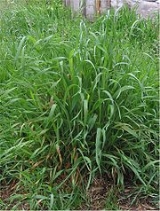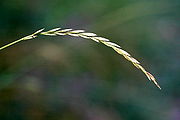
Elymus repens
Encyclopedia
Elymus repens Gould (couch grass; syn. Triticum repens L., Agropyron repens (L.) P. Beauv., Elytrigia repens
(L.
) Desv. ex Nevski) is a very common perennial species of grass
native to most of Europe
, Asia
, and northwest Africa
. Other names include twitch, quick grass, quitch grass (also just quitch), dog grass, quackgrass, scutch grass, and witchgrass.
 It has creeping rhizome
It has creeping rhizome
s which enable it to grow rapidly across grassland. The stems ('culms') grow to 40–150 cm tall; the leaves
are linear, 15–40 cm long and 3–10 mm broad at the base of the plant, with leaves higher on the stems 2–8.5 mm broad. The flower
spike is 10–30 cm long, with spikelets 1–2 cm long, 5–7 mm broad and 3 mm thick with three to eight florets. The glumes are 7–12 mm long, usually without an awn or with only a short one.
It flowers at the end of June through to August in the northern hemisphere.
.
are distinguished, one of these with an additional variety
:
Hybrids are recorded with several related grasses, including Elytrigia juncea (Elytrigia × laxa (Fr.) Kerguélen), Elytrigia atherica (Elytrigia × drucei Stace), and with the barley
species Hordeum secalinum (× Elytrordeum langei (K. Richt.) Hyl.).
s. The seed
s are eaten by several species of grassland bird
s, particularly buntings
and finch
es. The caterpillar
s of some Lepidoptera
use it as a foodplant, e.g. the Essex Skipper
(Thymelicus lineola).
throughout much of the world, and often listed as an invasive weed. It is very difficult to remove from garden environments,as each piece of rhizome
can develop into a new plant. One method is to dig deep into the ground in order to remove as much of the grass as possible. The area should then be covered with a thick layer of woodchips. To further prevent re-growth cardboard can be placed underneath the woodchips. The long, white rhizomes will, however, dry out and die if left on the surface. Many herbicides will also control it.
period. Sick dogs are known to dig up and eat the root, and mediaeval herbalist
s used it to treat inflamed bladder
s, painful urination and water retention
. It also has antiseptic properties.
in mediaeval Northern Europe where other resin-based types of incense were unavailable.
(L.
Carolus Linnaeus
Carl Linnaeus , also known after his ennoblement as , was a Swedish botanist, physician, and zoologist, who laid the foundations for the modern scheme of binomial nomenclature. He is known as the father of modern taxonomy, and is also considered one of the fathers of modern ecology...
) Desv. ex Nevski) is a very common perennial species of grass
Poaceae
The Poaceae is a large and nearly ubiquitous family of flowering plants. Members of this family are commonly called grasses, although the term "grass" is also applied to plants that are not in the Poaceae lineage, including the rushes and sedges...
native to most of Europe
Europe
Europe is, by convention, one of the world's seven continents. Comprising the westernmost peninsula of Eurasia, Europe is generally 'divided' from Asia to its east by the watershed divides of the Ural and Caucasus Mountains, the Ural River, the Caspian and Black Seas, and the waterways connecting...
, Asia
Asia
Asia is the world's largest and most populous continent, located primarily in the eastern and northern hemispheres. It covers 8.7% of the Earth's total surface area and with approximately 3.879 billion people, it hosts 60% of the world's current human population...
, and northwest Africa
Africa
Africa is the world's second largest and second most populous continent, after Asia. At about 30.2 million km² including adjacent islands, it covers 6% of the Earth's total surface area and 20.4% of the total land area...
. Other names include twitch, quick grass, quitch grass (also just quitch), dog grass, quackgrass, scutch grass, and witchgrass.
Description

Rhizome
In botany and dendrology, a rhizome is a characteristically horizontal stem of a plant that is usually found underground, often sending out roots and shoots from its nodes...
s which enable it to grow rapidly across grassland. The stems ('culms') grow to 40–150 cm tall; the leaves
Leaf
A leaf is an organ of a vascular plant, as defined in botanical terms, and in particular in plant morphology. Foliage is a mass noun that refers to leaves as a feature of plants....
are linear, 15–40 cm long and 3–10 mm broad at the base of the plant, with leaves higher on the stems 2–8.5 mm broad. The flower
Flower
A flower, sometimes known as a bloom or blossom, is the reproductive structure found in flowering plants . The biological function of a flower is to effect reproduction, usually by providing a mechanism for the union of sperm with eggs...
spike is 10–30 cm long, with spikelets 1–2 cm long, 5–7 mm broad and 3 mm thick with three to eight florets. The glumes are 7–12 mm long, usually without an awn or with only a short one.
It flowers at the end of June through to August in the northern hemisphere.
.
Taxonomy
Various taxonomic subdivisions of this species have been proposed. Moreover, it is assigned to various genera (Elymus, Elytrigium, Agropyron). In a recent classification, three subspeciesSubspecies
Subspecies in biological classification, is either a taxonomic rank subordinate to species, ora taxonomic unit in that rank . A subspecies cannot be recognized in isolation: a species will either be recognized as having no subspecies at all or two or more, never just one...
are distinguished, one of these with an additional variety
Variety (biology)
In botanical nomenclature, variety is a taxonomic rank below that of species: as such, it gets a three-part infraspecific name....
:
- Elytrigia repens subsp. repens. Throughout most of the range of the species.
- Elytrigia repens subsp. repens var. repens. Awns usually absent or if present, very short.
- Elytrigia repens subsp. repens var. aristata (Döll) P.D.Sell. Awns present, up to 15 mm long.
- Elytrigia repens subsp. elongatiformis (Drobow) Tzvelev (syn. Elytrigia elongatiformis (Drobow) Nevski). Central and southwestern Asia, far southeastern Europe (Ukraine).
- Elytrigia repens subsp. longearistata N. R. Cui. Western China (Xinjiang).
Hybrids are recorded with several related grasses, including Elytrigia juncea (Elytrigia × laxa (Fr.) Kerguélen), Elytrigia atherica (Elytrigia × drucei Stace), and with the barley
Barley
Barley is a major cereal grain, a member of the grass family. It serves as a major animal fodder, as a base malt for beer and certain distilled beverages, and as a component of various health foods...
species Hordeum secalinum (× Elytrordeum langei (K. Richt.) Hyl.).
Ecology
The foliage is an important forage grass for many grazing mammalMammal
Mammals are members of a class of air-breathing vertebrate animals characterised by the possession of endothermy, hair, three middle ear bones, and mammary glands functional in mothers with young...
s. The seed
Seed
A seed is a small embryonic plant enclosed in a covering called the seed coat, usually with some stored food. It is the product of the ripened ovule of gymnosperm and angiosperm plants which occurs after fertilization and some growth within the mother plant...
s are eaten by several species of grassland bird
Bird
Birds are feathered, winged, bipedal, endothermic , egg-laying, vertebrate animals. Around 10,000 living species and 188 families makes them the most speciose class of tetrapod vertebrates. They inhabit ecosystems across the globe, from the Arctic to the Antarctic. Extant birds range in size from...
s, particularly buntings
Bunting (bird)
Buntings are a group of Eurasian and African passerine birds of the family Emberizidae.They are seed-eating birds with stubby, conical bills, and are the Old World equivalents of the species known in North America as sparrows...
and finch
Finch
The true finches are passerine birds in the family Fringillidae. They are predominantly seed-eating songbirds. Most are native to the Northern Hemisphere, but one subfamily is endemic to the Neotropics, one to the Hawaiian Islands, and one subfamily – monotypic at genus level – is found...
es. The caterpillar
Caterpillar
Caterpillars are the larval form of members of the order Lepidoptera . They are mostly herbivorous in food habit, although some species are insectivorous. Caterpillars are voracious feeders and many of them are considered to be pests in agriculture...
s of some Lepidoptera
Lepidoptera
Lepidoptera is a large order of insects that includes moths and butterflies . It is one of the most widespread and widely recognizable insect orders in the world, encompassing moths and the three superfamilies of butterflies, skipper butterflies, and moth-butterflies...
use it as a foodplant, e.g. the Essex Skipper
Essex Skipper
The Essex Skipper is a butterfly of the Hesperiidae family. In North America, it is known as the European Skipper....
(Thymelicus lineola).
Cultivation and uses
Couch Grass has become naturalisedNaturalisation (biology)
In biology, naturalisation is any process by which a non-native organism spreads into the wild and its reproduction is sufficient to maintain its population. Such populations are said to be naturalised....
throughout much of the world, and often listed as an invasive weed. It is very difficult to remove from garden environments,as each piece of rhizome
Rhizome
In botany and dendrology, a rhizome is a characteristically horizontal stem of a plant that is usually found underground, often sending out roots and shoots from its nodes...
can develop into a new plant. One method is to dig deep into the ground in order to remove as much of the grass as possible. The area should then be covered with a thick layer of woodchips. To further prevent re-growth cardboard can be placed underneath the woodchips. The long, white rhizomes will, however, dry out and die if left on the surface. Many herbicides will also control it.
Medical use
Couch Grass has been used in herbal medicine since the Classical GreekClassical Greece
Classical Greece was a 200 year period in Greek culture lasting from the 5th through 4th centuries BC. This classical period had a powerful influence on the Roman Empire and greatly influenced the foundation of Western civilizations. Much of modern Western politics, artistic thought, such as...
period. Sick dogs are known to dig up and eat the root, and mediaeval herbalist
Herbalist
An herbalist is:#A person whose life is dedicated to the economic or medicinal uses of plants.#One skilled in the harvesting and collection of medicinal plants ....
s used it to treat inflamed bladder
Urinary bladder
The urinary bladder is the organ that collects urine excreted by the kidneys before disposal by urination. A hollow muscular, and distensible organ, the bladder sits on the pelvic floor...
s, painful urination and water retention
Water retention (medicine)
The term water retention signifies an abnormal accumulation of fluid in the circulatory system or within the tissues or cavities of the body.Water is found both inside and outside the body’s cells...
. It also has antiseptic properties.
Other uses
The dried rhizomes of couch grass were broken up and used as incenseIncense
Incense is composed of aromatic biotic materials, which release fragrant smoke when burned. The term "incense" refers to the substance itself, rather than to the odor that it produces. It is used in religious ceremonies, ritual purification, aromatherapy, meditation, for creating a mood, and for...
in mediaeval Northern Europe where other resin-based types of incense were unavailable.
External Links
- Species Profile- Quackgrass (Elymus repens), National Invasive Species Information Center, United States National Agricultural LibraryUnited States National Agricultural LibraryThe United States National Agricultural Library is one of the world's largest agricultural research libraries, and serves as a National Library of the United States and as the library of the United States Department of Agriculture...
. Lists general information and resources for Quackgrass.

